Assam – Culture and Tradition
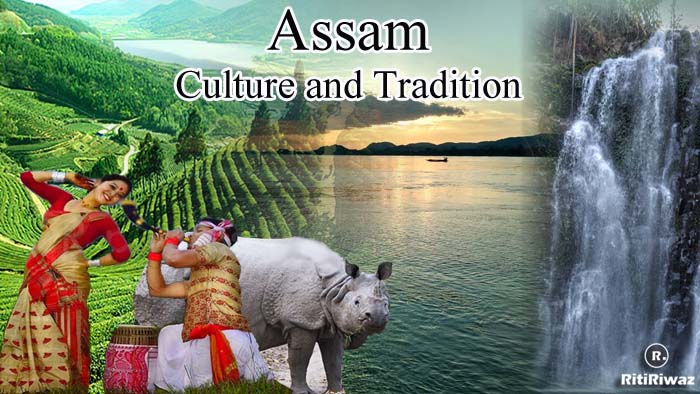
Assam (The land of the red river and blue hills) is a Northeastern state in India that is also called Gateway of Northeast India. It is bordered by Bhutan and Arunachal Pradesh in the north, Nagaland, Manipur, and Burma in the east, while Bangladesh, Tripura, and Mizoram in the south while West Bengal in the west.
Assam along with Arunachal Pradesh, Nagaland, Manipur, Mizoram, Tripura, and Meghalaya is known as Seven Sisters. The Seven sister states are also referred to as “Paradise Unexplored“.
The reason it is called the “Seven Sisters” is the similarity between the states, in terms of geographical features, and interdependence among them in the political, social, and economic spheres. All seven states of the seven sisters are isolated from India and the only way to reach there is via Siliguri Corridor (Chicken Neck) in Assam.
The capital of Assam is Dispur and most of the state lies in the valley of the mighty river Brahmaputra. The river Brahmaputra also forms the world’s largest island the river called Majuli.
One-horned Indian rhinoceros is nearly extinct and conserved in Assam. The state receives more rainfall than most parts of India. These rains feed the Brahmaputra river and help in the formation of a hydro-geomorphic environment in Assam throughout the year.
Assam is gifted with lush green meadows, fertile plains near the enormous Brahmaputra river, beautiful hills with wonderful tea plantations, and rich flora and fauna. Its pleasant climate throughout the year makes it best for tourism in Assam.
History
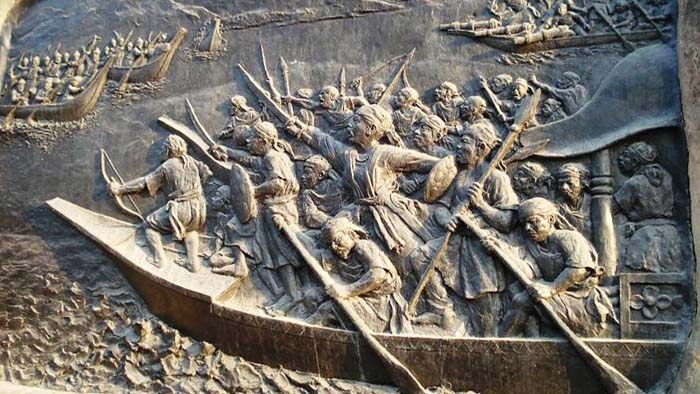
The roots of Assamese culture go back almost two thousand years when the first cultural assimilation took place between Austro-Asiatic and Tibeto-Burman groups.
There were three waves of cultural assimilation in Assam. First, it was the Tibeto-Burman ethnic groups that had arrived from Tibet, Yunnan, and Sichuan provinces of China who mixed with the scarcely present aboriginal Austric people like the Khasi and Jaintia.
Then there was a wave of Indo-Aryans from Northern India, which brought the Vedic culture and Hinduism into Assam.
The last wave of migration was that of the Ahoms (Tai/Shan) who added another chapter to the Assamese culture. The Ahoms, later on, brought some more Indo-Aryans like the Assamese Brahmins and Ganaks, and Assamese Kayasthas to Assam. The Assam we know today was founded by the Ahom kings.
During the six hundred years of ruling, the Ahom dynasty managed to keep the kingdom, independent from Mughal, the muslin invaders of India before the British, as well as other invaders though Mughal attacked Assam seventeen times. During this era, the Assamese society was exogenous.
The British entered Assam in 1824 as a tea planter which was the starting point of the destruction of the Ahom dynasty. Along with the British, the immigrants entered Assam from India together with their traditional beliefs such as the caste system and dowry system. Some of the immigrants become a part of the Assamese society, and the others still practice their traditions.
British ruled till 1947. With the freedom of India, Assam also became able to achieve independence and became a part of it. Since then Assam has been passing her time as a part of the Indian union.
Culture
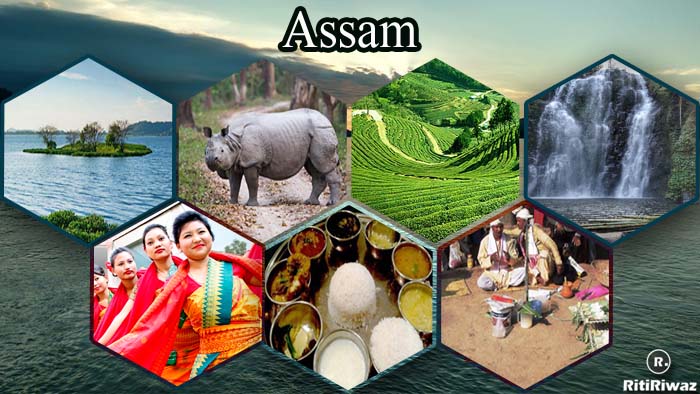
Assam culture is influenced by the Ahom dynasty and the Koch kingdom who ruled the region for many years. One of the major cultural changes was brought about by the Vaishnava movement.
The native people of Assam are called Asomiya (Assamese), they are a mixture of Mongoloid, Indo-Burmese, Indo-Iranian, and Aryan. Their culture has evolved through a long assimilation process of various races.
The state has a large number of tribes out of which Boro is the largest tribe in Assam, while Chakma, Chutiya, Dimasa, Hajong, Garo, Khasis, Gangte, and other tribes are also there. While the majority of the Assamese are of the Vaishnava tribe among which social institutions such as Namghar (house of prayer) and Sattra (the site of religious and cultural practice) became popular.
Suggested Read: Culture and Tradition of Indian States
Language
The people of Assam speak the language Assamese, it is an Indo-Aryan language and is the official language of the state.
Costume
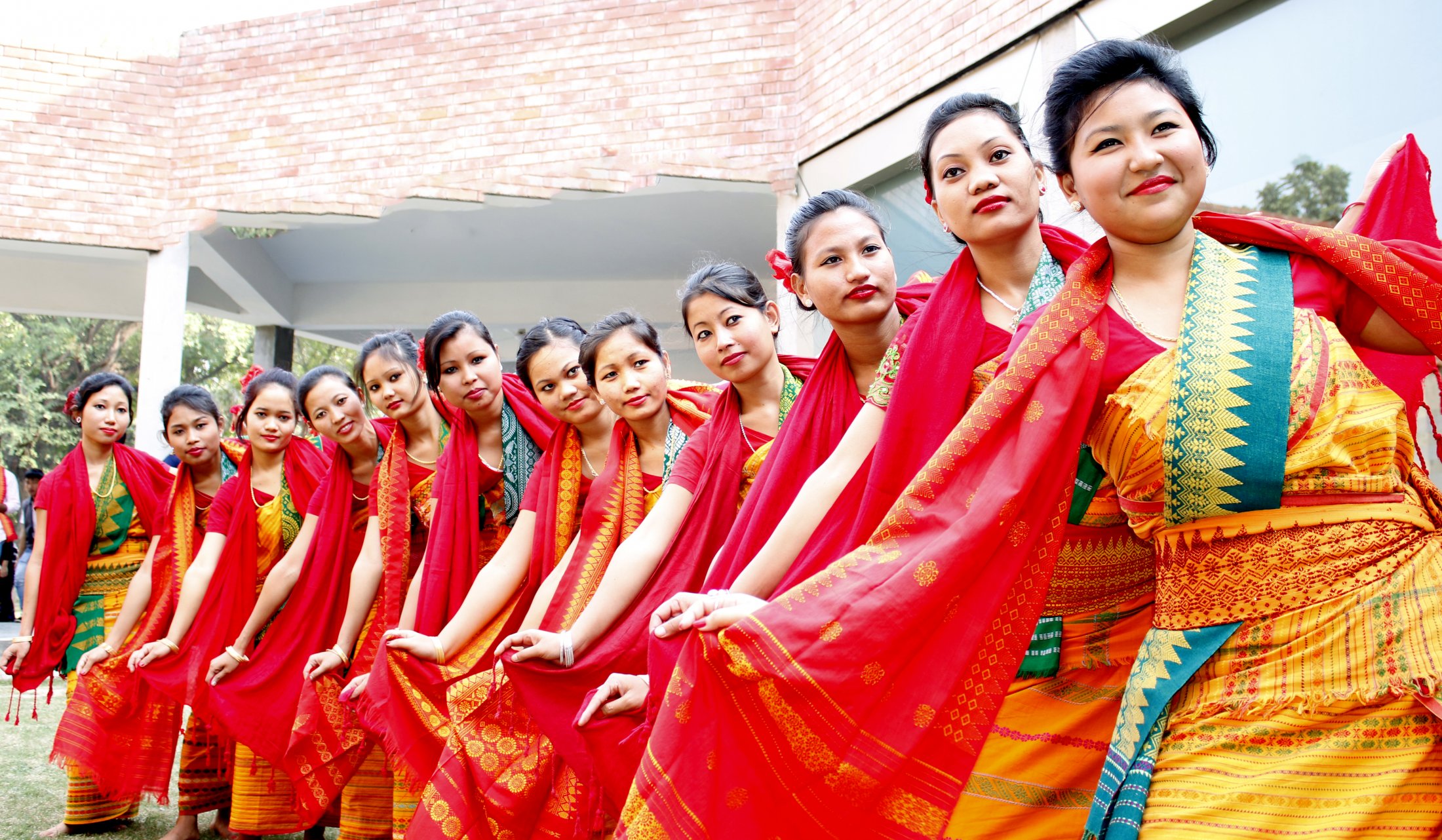
Assamese men wear Dhoti Gamosa, dhoti is a piece of garment worn in the lower part of the body. The dhoti is wrapped around the waist while Gamosa is a cloth rectangular in shape with a red border on three sides used to wipe hands.
Assamese women wear Mekhela Chador, which is a two-piece garment worn both by young and old, but not by children. It is draped from the waist to downward and later tucked into the waist with a triangular fold. Mekhela is worn around the waist with few folds and the chador is draped around the body and bringing it back to the waist and tucked in.
Although it looks like a saree it is different from a saree as it got two parts Mekhela and Chador. Traditional dresses are made of Muga silk which is the pride of Assam and is very peculiar.
Suggested Read: Nicknames of Indian States
Cuisines
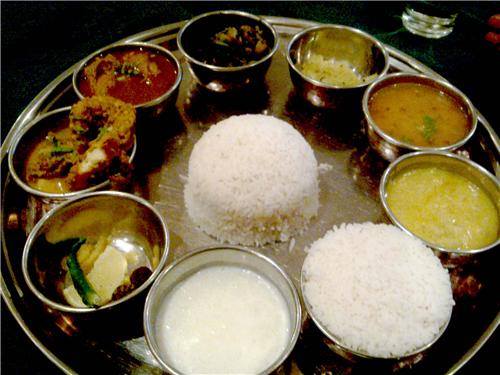
Assamese cuisine is a combination of the cooking technique used by people living in hilly regions and those living on plains. A traditional Assamese meal begins with Khar and ends with a spicy and tangy Tenga, Betelnut and paan conclude the meal.
Some traditional Assamese dishes are pura maas mankho, dheakiyasak, pitika etc. A typical Assamese meal has rice (bhat) and dal masoor jool (fish curry) with mangxo (meat curry) and bhaji (herbs and vegetables).
A variety of rice is grown in Assam and is used as the main dish. Fish curry is made of wild fish like Borali, Rou, Illish or Sital. Fowl such as ducks and pigeons are also used while pork, chicken, and mutton are much popular among youngsters.
Other kinds of meat include grasshoppers, locusts, silkworms, snails, eels, wildfowl, birds, and deer meat.
Khorisa is fermented bamboo shoots used to flavor curries, Koldil (bamboo flower), and squash are used as vegetables.
They traditionally brew their drinks in the home like Laupani, Xaaj, Paniyo, Jou, joumai, Hot, Apang, and are offered festive to guests.
Suggested Read: Famous Food Of Indian States
Dance
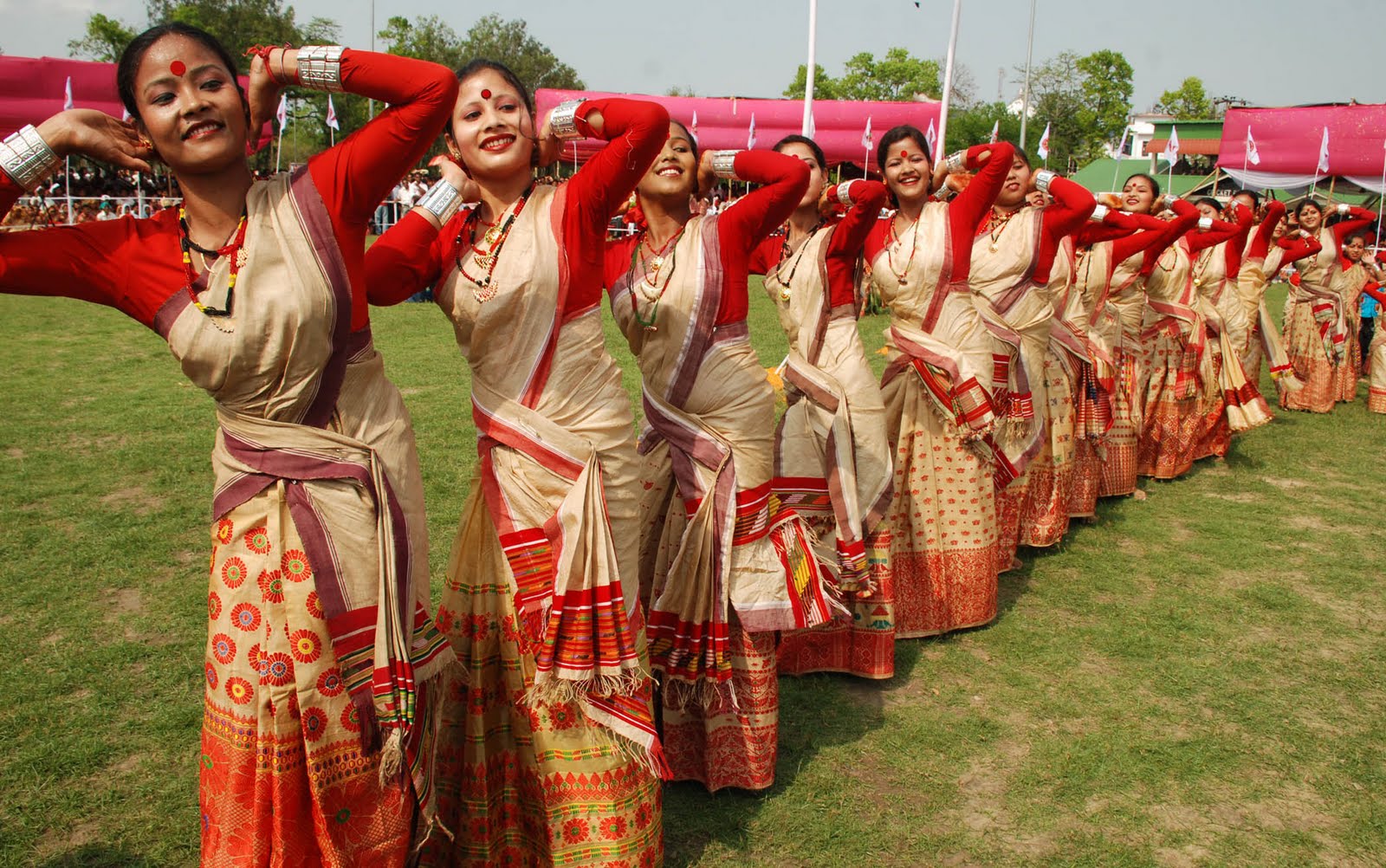
Bihu is a very popular festival celebrated all over Assam and Bihu dance is very popular during this festival and performed in open with friends and relatives, in which Dhol and Pepa is an essential part.
Jhumar Nach, Bagurumba, Ankia Naat, Kushan Nritra, Mishing Bidu etc also popular. Folk songs of Assam include Borgeet.
Art and Crafts
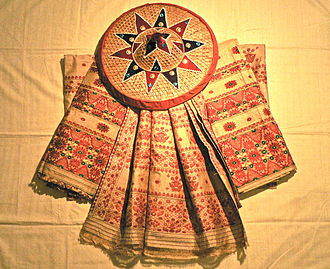
Weaving is a traditional craft of the Assamese and every woman takes pride in their handloom possessions. They produce clothes of silk and cotton in their handlooms. The important silk products of Assam are Eri, Muga, and Pat. The worms which produce Muga silk is Antehra Assam. These worms can only survive in the northwestern climate.
Once Gandhiji complimented Assamese weavers as an artist who could weave dreams in their looms. They weave fine silk and cotton cloths of various floral patterns and other designs. Traditional crafts like pottery and terracotta work, bell metal, and brass crafts, jewelry making, musical instrument making, and cane and bamboo craft is also popular.
Festivals
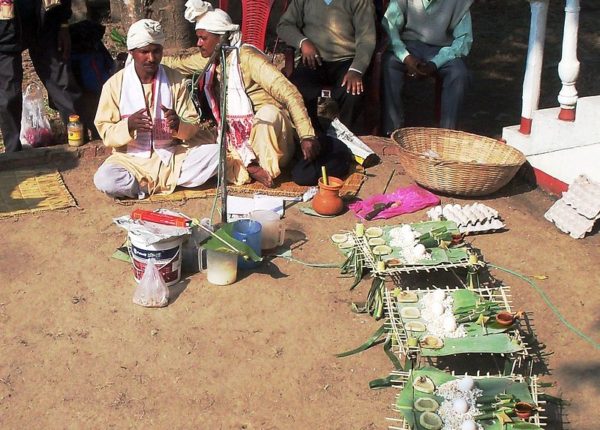
Bihu is the main festival celebrated in the region where everybody irrespective of their religion observes the festival with great enthusiasm.
The Bohag Bihu is celebrated in Mid-April, also called Rangaali Bihu, and is observed by dancing and singing in open with friends and relatives.
The second important Bihu is Magh Bihu celebrated in Mid-January also called as harvest festival (Bhogaali Bihu) and is usually celebrated with community bonfires and feasts.
The third is Kangaali Bihu celebrated in Mid-October, it is the time of the year when the harvest is brought home. Other festivals observed in the region are Durga puja, Dol-jatra or Fakuwa, Janamasthami, and Eid.
Suggested Read: Me-dam-me-phi
Assam Tea
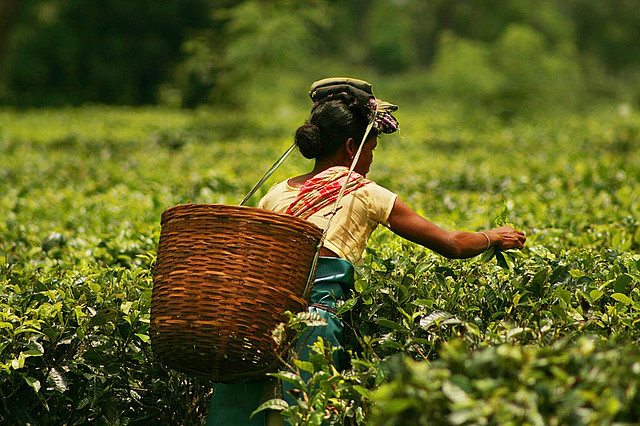
Assam is known for Assam Tea and Assam Silk. Assam tea is known for its deep burgundy-red cup and pungent flavor and is famous all over the world. Assam is the single largest tea-growing region and it produces more than half of India’s tea.
Tourism

Assam “The land of red rivers and blue hills” is known for its wildlife and tea plantation. The state is dominated by the mighty river the Brahmaputra. The dense forest of Assam is home to numerous animals and birds as well as Asian elephants.
Be it the natural scenery or culture of the people of Assam, you are sure to be awed by the variety and color Assam has to offer. Assam is also well known for its incomparable tea, and silk, and above all its rich biodiversity is popular for enjoying eco-vacations.
It is home to five national parks among which two are designated World Natural Heritage Sites by UNESCO, and several wildlife and bird sanctuaries, Assam is a blessed land for wildlife enthusiasts.

1. Kaziranga National Park
2. Dibru Saikhowa National Park
3. Manas National Park
4. Nameri National Park
5. Orang National Park
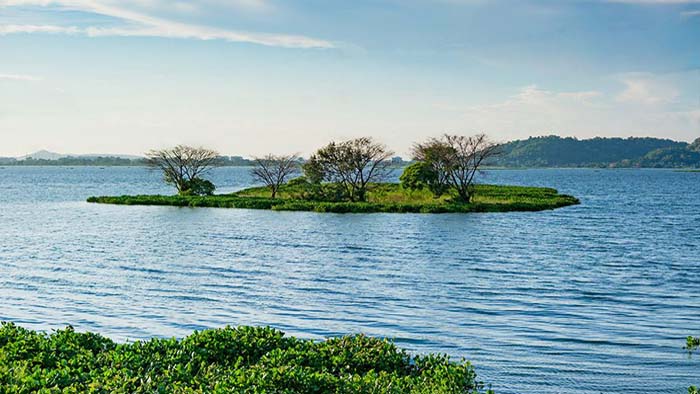
Best Places to visit in Assam are.
Guwahati, Sualkuchi – Where you can see muga silk, pat silk, and eri silk, Hajo, Tezpur, Majuli – Biggest inhabited river island in the world, Digboi – Oldest oil refinery in Asia.
Kamakhya Temple – The most visited temple in eastern India is an ancient and historical temple situated in Guwahati, and Sivasagar – The home of the Ahom Kingdom, one of the longest-reigning dynasties in the country.
Historical places like Sivasagar- Rang ghar, kareng ghar, tolatol ghor, namdang stone bridge, and more. Tezpur – Agnigarh, koliya bhumura bridge, etc. ISKCON Guwahati, Assam State Zoo, Basistha Ashram Temple, Temples of Hajo, Shrimanta Shankardeva Kalakshetra, Uma Nanda Temple, Assam Rajyik State Museum, Bhuvaneswari Temple, Nehru Park, Vashistha Temple, these are also the renowned tourist points of this state.






